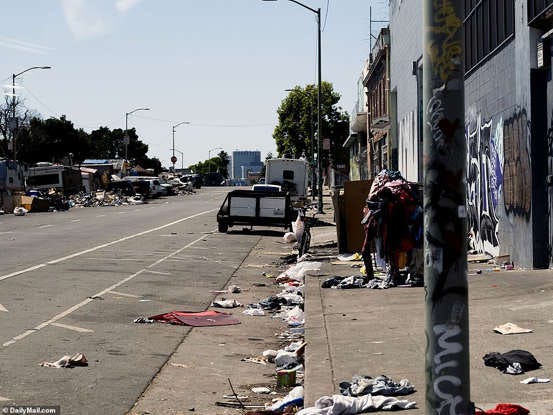California, attributing it to a series of progressive policies enacted by California politicians, most notably Kamala Harris, who they believe are motivated by personal gain and ideological extremism. They argue that these policies have fostered a rise in crime, particularly in Los Angeles, with organized criminal activity controlled by Mexican drug cartels. The authors also criticize the state's immigration policies and the power of the tech industry in San Francisco, which they see as contributing to a widening social divide and the erosion of California's former prosperity.
Critics of California’s recent governance argue that a series of progressive policies, backed by leading politicians like Kamala Harris, have inadvertently spurred a rise in crime and social inequality. Central to these concerns is the notion that some policymakers may be driven by personal or ideological motives rather than practical solutions to California's challenges. These critics see policies intended to reform the criminal justice system—such as reductions in sentences for non-violent crimes and the decriminalization of certain offenses—as contributing to an environment that emboldens criminal activity. Los Angeles, they argue, has borne the brunt of these shifts, with rising incidents of organized crime allegedly tied to Mexican drug cartels exploiting weaknesses in enforcement.
Additionally, critics argue that California’s relatively lenient stance on immigration, coupled with sanctuary city policies, has attracted an influx of undocumented individuals, further straining resources and complicating crime prevention efforts. Many express concern that these policies prioritize political ideology over the economic realities faced by California's residents, especially lower-income and middle-class communities who have seen rising costs and stagnant wages.
San Francisco, home to many of the world’s most powerful tech companies, is also a focal point of criticism. Detractors contend that the wealth generated by the tech industry has paradoxically exacerbated social divides, driving up housing costs and creating an economic environment that favors the wealthy elite while marginalizing large portions of the population. The proliferation of high-paying tech jobs has intensified income disparity, contributing to a homelessness crisis and creating visible social stratification in urban centers. This widening gap between the ultra-wealthy and those struggling with high living costs and limited housing options has led some to argue that California’s progressive model has undermined the state’s historical prosperity and social balance.
In the eyes of critics, these issues collectively signal an erosion of California's once-celebrated prosperity, leaving many questioning whether the state's policies serve the public good or a narrower ideological vision. However, supporters argue that California's progressive reforms aim to address systemic inequalities, foster innovation, and create a more inclusive economy—yet the debate continues as the state grapples with finding a sustainable path forward.
The portrayal of California’s future by its critics is stark, highlighting societal decay, economic disparity, and political stagnation as symptoms of a once-thriving state now on an alleged path toward dystopia. At the forefront of this critique is the contention that recent progressive policies, particularly in criminal justice reform, have dismantled essential protections and empowered criminal networks. Laws like AB 109, Prop 47, and Prop 57 are cited repeatedly as pivotal shifts that, in the critics’ view, prioritize offenders’ rights over the security of everyday citizens. These policies, combined with the growing influence of Mexican drug cartels, are seen as transforming Los Angeles and other urban centers into environments where lawlessness has escalated, jeopardizing the safety and stability of communities. Narratives of home invasions, gang violence, and street-level drug crises are often used to illustrate a state of emergency, where residents feel increasingly vulnerable.
Another major criticism involves the perceived undermining of law enforcement. Opponents argue that the morale and operational effectiveness of police forces are waning due to policies that limit their authority and undermine their efficacy. The recruitment of DACA recipients into the LAPD—some of whom are not allowed to carry firearms—has fueled accusations that political motives are driving personnel decisions at the cost of public safety. Such measures, they argue, erode confidence in law enforcement’s capacity to address escalating crime and reinforce a perception that the state’s leadership is prioritizing ideological goals over pragmatic solutions.
Beyond the immediate safety concerns, critics point to a broader erosion within California’s justice system, emphasizing measures like the abolition of cash bail, sentencing enhancements, and support for victims at parole hearings as emblematic of a system skewed toward leniency. They contend that these policies fail to hold criminals accountable, fostering a climate of impunity that fuels bolder and more frequent offenses. The justice system, in this view, has strayed from its core mission, leaving victims to navigate an environment where accountability feels elusive.
California’s economic model is another focal point of critique. While the state’s tech sector has brought unprecedented wealth, critics argue that this prosperity has been confined to a select few, creating a deeply polarized society. Tech industry leaders, often characterized as an elite class removed from the daily realities of California life, are accused of living in isolated enclaves, far removed from the issues of homelessness, crime, and economic hardship that increasingly define the state. This economic schism, they argue, has stripped the upper class of a traditional sense of “noblesse oblige”—a social duty to uplift others. Instead, critics claim, the affluent seem to prioritize self-interest, exacerbating inequality and leaving California’s middle and working classes struggling to survive.
The exodus of middle-class Californians from the state is presented as a grim indication of these trends. Faced with soaring housing costs, burdensome regulations, and diminishing quality of life, many in the middle class are choosing to leave California altogether, a trend that critics argue is hollowing out the state’s economic base. They see this as a key indicator of California’s decline: a state once synonymous with opportunity now increasingly perceived as unlivable for those outside the wealthiest tiers. With the middle class shrinking and poverty on the rise, California risks entrenching an economically stratified society that could be difficult to reverse.
Politically, critics view California’s challenges as exacerbated by one-party rule, a landscape dominated by Democrats that they argue has fostered an environment ripe for inefficiency, lack of accountability, and ideological excesses. The near absence of a counterbalancing force in government has, they contend, allowed policies to be implemented with little regard for dissenting voices, leading to what some describe as a “political machine” more concerned with perpetuating its own dominance than addressing the real needs of Californians. Such entrenched political power, critics argue, has led to corruption and self-serving agendas, further alienating those who feel unrepresented in the political process.
For those critical of California’s trajectory, the state serves as a cautionary tale for the nation. They argue that the consequences of progressive policies and political monopolies seen in California could foreshadow broader issues if adopted on a national scale. The rise of organized crime, unchecked ideological policymaking, and deepening social rifts are perceived as potential risks that could replicate themselves beyond California’s borders. This perspective urges a re-evaluation of the policies that critics believe have led to California’s decline and serves as a rallying cry against what they see as a perilous model for the rest of the country.
Though some may view this narrative as overly bleak, the critiques offer a pointed reminder of the risks of unchecked social experimentation, economic disparity, and single-party governance. Whether this foreboding vision of California’s future is fully realized remains an open question, but the arguments underscore the complexities and challenges facing a state grappling with profound transformations. The lessons drawn from California’s trajectory, for better or worse, are likely to resonate as the nation navigates its own political and social crossroads.
The portrait of California’s decline offered by its critics is unrelentingly grim, casting the state as a harbinger of societal breakdown, where misguided policies and entrenched political power have created a cycle of disorder and inequality. Central to this narrative is the assertion that lenient criminal justice policies—embodied in laws like AB 109, Prop 47, and Prop 57—have not only failed to deliver on the promises of reform but have exacerbated crime and insecurity across the state. Originally aimed at reducing overcrowding in prisons and addressing racial disparities in sentencing, these laws are viewed as having swung too far in favor of leniency, leading to early releases for offenders with troubling histories and a justice system that many feel now prioritizes the welfare of criminals over the safety of law-abiding citizens. The classification of “nonviolent” offenders under these laws is seen as overly broad, allowing for the release of individuals with potentially violent pasts and creating a pervasive fear of lawlessness among residents.
Fueling these changes, the broader criminal justice reform movement has become a focal point of blame. Figures like Mike Romano, the Stanford law professor who authored Proposition 47, and financier George Soros, a prominent supporter of criminal justice reform, are often depicted as orchestrators of policies that critics claim prioritize offenders’ rights at the expense of public safety. This movement, driven by a desire to address systemic injustices, is seen by some as having lost its original intent, instead introducing what one source describes as “suffering as a policy choice.” Particularly alarming to these critics is the claim that affluent, predominantly white communities have become new targets of crime, with some alleging that reformist agendas have taken an unsettling turn by imposing suffering indiscriminately to promote “equity” in harm.
Further compounding these problems, the influence of Mexican drug cartels on California’s criminal landscape is perceived as a grave threat, with cartels allegedly controlling the state’s prison gangs and dictating the flow of narcotics and other illicit enterprises. This alleged cartel dominance has reportedly stoked an atmosphere of violence, with the lines between street gangs and organized cartel operations blurring. The critics argue that the cartels’ deep-rooted presence in the state, coupled with a weakened law enforcement apparatus, has given rise to a dangerous criminal economy where the cartels operate with minimal resistance. This view depicts California as a battleground, where local and international criminal networks hold significant sway and the state’s enforcement capabilities have been thoroughly compromised.
Economic factors are also cited as instrumental in California’s decline, with the state’s deindustrialization and the concurrent boom of its tech industry seen as sources of growing inequality and societal fragmentation. The disappearance of California’s manufacturing sector has been mirrored by the rise of a concentrated tech elite in Silicon Valley, whose immense wealth and influence have distanced them from the realities facing the majority of Californians. This economic divide, critics argue, has left an increasingly detached upper class that no longer feels obligated to address the needs of the less fortunate. This perceived erosion of “noblesse oblige”—the traditional moral duty of the affluent to uplift those around them—has led to a society in which the wealthy seem isolated in affluent enclaves, while the middle and working classes bear the brunt of rising living costs, inadequate services, and neighborhood-level crime.
The challenges facing California are further attributed to the state’s one-party dominance, with Democrats controlling nearly every aspect of the state’s political machinery. Critics argue that this overwhelming control has fostered a political culture in which corruption and self-interest can flourish unchecked, and policies are advanced with little opposition or accountability. This one-party rule is said to have created an environment where ideological agendas—rather than pragmatic solutions—shape the legislative landscape. Laws such as the Racial Justice Act and AB 3070, designed to address racial bias within the legal system, are pointed to as examples of legislation that critics claim push ideological boundaries without practical foresight. Some speculate that the Supreme Court may ultimately overturn such measures, interpreting them as excessive or unconstitutional. However, until such checks occur, these policies remain emblematic of what opponents view as a political apparatus more invested in ideology than in effectively governing a diverse and populous state.
Beneath these policy critiques lies a deeper lamentation over what is seen as an erosion of California’s traditional values, particularly those rooted in Christianity, which some argue once underpinned the state’s cultural cohesion and moral fabric. With secular and progressive ideologies becoming dominant in the state’s politics, critics contend that California’s ruling class now espouses a worldview detached from the ethical principles that historically fostered social responsibility and a sense of shared destiny. This alleged loss of traditional values is seen as having replaced a community-oriented ethic with self-interest and a detachment from the hardships faced by ordinary citizens, creating a society that feels increasingly fragmented and purposeless.
The cumulative effect of these policies and cultural shifts, according to critics, has left California teetering on the brink of collapse, drawing comparisons to the decline of the Roman Empire. The state’s trajectory, they argue, should serve as a warning to the rest of the country, illuminating the risks of unchecked progressive governance, criminal leniency, and economic bifurcation. For these critics, California’s challenges exemplify the potential pitfalls of prioritizing ideology over pragmatic governance and individual safety. While supporters of the state’s reforms may see them as necessary steps toward social justice and a more inclusive society, detractors maintain that the current approach is unsustainable and poses a broader risk should similar policies gain traction nationally.
Whether this grim assessment will ultimately define California’s future remains to be seen, as the state continues to navigate the pressures of social reform, economic inequality, and shifting demographics. Yet the warnings resonate: the issues facing California today are not merely regional but indicative of broader challenges that may shape America’s social and political landscape in the coming years.
California’s future, according to its most vocal critics, presents a stark warning not only to the state itself but to the nation at large. In their view, current trends of criminal leniency, demographic shifts, and economic upheaval have placed California on an unsustainable path. The debate over the state’s criminal justice system lies at the center of this narrative. Laws such as AB 109, Prop 47, and Prop 57, designed to reduce overcrowding in prisons, are now seen as the linchpin of California’s alleged “lawlessness.” These measures have relaxed sentencing, reclassified certain felonies as misdemeanors, and offered expanded parole opportunities to “nonviolent” offenders, a category which critics argue is both overly broad and misleading. For instance, critics point to the reclassification of theft and drug possession, viewing this as an invitation to disorder and as a primary driver of property crime and drug use in the state. According to this line of reasoning, the justice system now favors offenders over citizens’ safety, perpetuating a dangerous cycle.
Compounding this, they argue, is the Criminal Justice Reform movement, led by figures such as Mike Romano and backed by financiers like George Soros. This movement, originally intended to address racial disparities and promote fairness, is seen as ideologically motivated to reduce incarceration at any cost. Critics accuse it of fostering a climate where offenders’ rights are given precedence over the safety and welfare of communities. This perceived prioritization has, they argue, damaged public trust in the justice system. Observers worry that California’s liberal reforms, if replicated elsewhere, could extend a similar culture of impunity throughout the nation.
Another factor cited by critics is the rise of Mexican drug cartels, which they claim have gained control of California’s criminal economy, wielding influence over both street gangs and prison syndicates. According to these sources, the cartels exert their control through violence and intimidation, running illicit enterprises with minimal resistance and fueling an atmosphere of fear. The Mexican Mafia and similar prison gangs are accused of working hand-in-hand with the cartels to maintain control over narcotics distribution, human trafficking, and other underground markets, creating what critics see as a “shadow government” that operates outside the rule of law. This development is seen as evidence that California’s leniency is not merely a matter of isolated policy errors but a foundational issue undermining public order.
In addition to criminal justice, the state’s demographic and economic transformations add to this grim portrayal. The influx of undocumented immigrants, for instance, is blamed for complicating law enforcement and overburdening social services, while policies favoring Deferred Action for Childhood Arrivals (DACA) recipients in police recruitment are viewed as undermining the quality of the police force. Opponents of such policies argue that they contribute to a bifurcated justice system in which illegal immigrants receive protections and plea deals not afforded to citizens, sowing discontent and division.
Critics also highlight California’s economic evolution, particularly the deindustrialization of once-thriving manufacturing sectors and the concurrent rise of the tech industry. The rapid ascendance of Silicon Valley has, in their view, introduced new social strains, including escalating income inequality, homelessness, and social isolation. The state’s high cost of living, largely a consequence of its economic restructuring, has driven the middle class out in droves, replaced by a growing disparity between the tech elite and an increasingly marginalized working class. While Silicon Valley’s wealth has undoubtedly brought economic vitality, it has also widened social gaps, producing what critics describe as an “insular bubble” that has little stake in the broader state’s welfare.
Overlaying these social and economic shifts, critics argue, is the unchallenged rule of the Democratic Party, which has controlled California’s legislature and governorship for decades. This one-party dominance is viewed as a breeding ground for political dysfunction and lack of accountability. Critics contend that California’s leadership prioritizes ideological agendas over effective governance, citing laws such as the Racial Justice Act and AB 3070 as examples of legislation that, while well-intentioned, may be vulnerable to legal challenges on constitutional grounds. They argue that unchecked political dominance has turned California into a proving ground for progressive policies that, in their view, have little regard for unintended consequences.
Beneath the surface of these policy critiques lies a broader concern over an erosion of California’s traditional values, particularly those rooted in Christian ethics and a sense of civic responsibility. According to this view, the wealthy elite in California no longer feel bound by a “noblesse oblige” to the less fortunate, and the cultural shift toward secularism and progressivism has diminished empathy and social cohesion. Critics argue that this cultural shift has produced a leadership class that prioritizes self-interest and ideological purity over the well-being of ordinary Californians, leading to what they see as an increasingly fragmented society.
For these critics, California’s decline serves as a cautionary tale for the rest of the nation, warning of the perils of embracing progressive policies without adequate consideration for the social fabric. The state’s trajectory, they argue, illustrates how well-meaning reforms can exacerbate social division and weaken trust in public institutions. With crime on the rise, an economy that caters increasingly to the few, and an entrenched political class resistant to change, they fear that California may be beyond repair. The exodus of residents and businesses, fleeing high taxes, crime, and a declining quality of life, is viewed as symptomatic of an underlying dysfunction that may not easily be reversed.
The outlook painted by these sources is pessimistic, as they foresee a California that, unless corrective measures are taken, may be destined for continued social breakdown, economic decline, and political instability. The question of whether California can course-correct, these critics suggest, will depend on a willingness to address the structural challenges underlying its current woes and perhaps to embrace a return to traditional values and a more balanced governance. For now, however, California stands as a symbol, to its critics, of a society at a critical juncture—one where ideological fervor risks overwhelming practical governance and eroding the foundations of a once-prosperous state.















Share this post